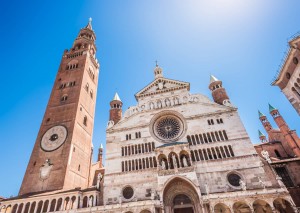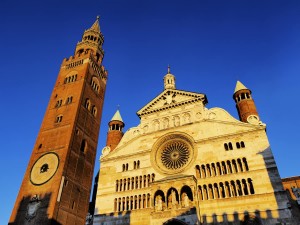
©Bigstock.com/Ibryan
Situated on the left bank of the Po river near the border to Emilia Romagna, there’s a genuine Lombard insiders’ tip waiting to be discovered by you. To be fair, Cremona isn’t what you’d necessarily call a prime holiday destination. The charming city in the south of the region with just over 72,000 inhabitants is a clear case of small but beautiful. Did you know, for example, that Cremona can look back on a rich history of violin craftmanship that is part of the UNESCO’s intangible cultural heritage? Or that it is home to one of the tallest brickwork bell towers in Europe? Well then, time to check out this lovely city.
A historical rollercoaster of emotions and rulers
Like Piacenza, Cremona was founded in 218 BC as a Roman military outpost for protection against Gallic tribes. New settlers were sent to the colony a few years later allowing it to blossom and eventually gain municipium rights. Troops of future emperor Vespasian destroyed Cremona in 69 AD after the Second Battle of Bedriacum – one of the reasons why you will find hardly any ancient traces. Despite Vespasian ordering immediate rebuilding, its former wealth was gone. The Lombards, too, would destroy and rebuild Cremona several centuries later.
Things became fairly quiet for a long time after. Cremona changed sides several times during the 11th and 12th century, supported Barbarossa and still later joined the Lombard League. Being faithful to the empire, it supported the Ghibellines during the Battle of Parma – some of Cremona’s most beautiful buildings date back to this era – until the Guelphs, former enemies, took over. You will hardly be surprised that this period resulted in several rebellions and loss of many rights. Rulers would then change frequently until Cremona became part of the House of Habsburg. It was heavily contested during the War of the Spanish Succession in 1702 before returning to the Austrian Habsburgs and blossoming. That’s where Cremona remained – not counting a Napoleonic intermezzo – until the defeat in the Austro-Sardinian War around 1860. The city became part of the newly founded Kingdom of Italy.
The Cathedral of Cremona

©Bigstock.com
Many of Cremona’s most beautiful buildings date back to the Middle Ages, and here’s an excellent example. The city’s cathedral, Duomo di Cremona or Cattedrale di Santa Maria Assunta, joins the Baptistery and the bell tower Torrazzo to form Cremona’s architectural centrepiece. While the foundation was laid as early as 1107, the cathedral wasn’t consecrated until 1190 due to a devastating earthquake. The campanile, the transept, the façade and the narthex, which now dominates the piazza, were added in later times. Therefore, the cathedral only gained its modern look in the 15th century.
An impressive marble façade with rich decoration rises around the elaborately designed Romanesque porch. A massive rose window and four Romanesque ambulatories add to this composition. The upper part, however, features distinct early Renaissance characteristics. By contrast, the side façades of transept seem fairly plain – something you most certainly cannot say about the cathedral interior with its plethora of awe-inspiring ornamentations and embellishments. The large altar cross made of gilded silver will most definitely catch your eye. It was made of more than 1,000 different parts with 160 statues. Paintings and frescoes by Il Pordenone, Boccaccino and Amadeo cap off the monumental overall impression.
Two other, similarly impressive buildings are also part of this architectural ensemble:
- Baptistery: Annexed to the cathedral, the octagonal Battistero di Cremona rises to the left. It is a magnificent piece where Romanesque and Lombard-Gothic architecture collide – the latter being particularly visible in the bare brickwork walls – even though the marble elements can be attributed to later restorations. Another large altar cross and several statues adorn the interior.
- Torrazzo: Finished in 1309, the campanile is the third-tallest brickwork bell tower in Europe behind Landshut and Bruges. Being 112.7 m in height, it is also the tallest still standing building exceeding 100 m of its kind. Furthermore, the Torrazzo is home to the largest astronomical clock in the world. Its zodiac constellations were repainted and altered multiple times over the course of history.
Cultural and musical Cremona
Time for an architectural break! The city of arts Cremona is intrinsically tied to its cultural and musical heritage. Violin players gush about it, if just mention the name. While the cathedral had been an important regional musical centre during the late Middle Ages, Cremona would blossom as a centre of musical instrument craftsmanship during the 16th century. Some of the world’s most renowned violin crafting families come and/or operated from Cremona. The Amati and Rugeri families were the pioneers, the Guarneri and Bergonzi took over later. And, of course, there’s Antonio Stradivari, probably the most famous son of the city. His instruments now sell for millions. Even today there are still more than 140 craftsmen in and around Cremona.
The traditional violin craftmanship in Cremona was granted intangible cultural heritage status by the UNESCO in 2012. The Museo del violino opened only one year later. This violin museum spread across ten rooms in the Palazzo dell’Arte is entirely dedicated to the multifaceted history of the instrument ranging from its origins to the master craftsmen to modern use. Performances with old and new instruments from Cremona regularly take place in the auditorium.
Don’t miss out on these gems!
We end our highly fascinating musical intermezzo as Cremona has a few more gems to offer beyond violin craftsmanship and the cathedral complex. Here are some of our favourites:
- Museo Civico Ala Ponzone: There many ways this city of arts expresses, well, art. You can find some of Cremona’s most beautiful pieces exhibited in this museum. Most of the original collection was donated by Giuseppe Sigismondo Ala Ponzone in 1842 including works by Arcimboldi and Caravaggio. Find another highlight in the Sala del Platina. The Renaissance wooden sacristy cabinet Armadio del Platina used to be in the Cathedral of Cremona.
- San Sigismondo: This complex of churches is located slightly outside the city centre. San Sigismondo was originally a monastery built in 1463 to honour the new connection of the previously rival Sforza and Visconti families. Don’t sleep on the masterful frescoes by Bernardino Gatti in the cupola!
- San Marcellino e Pietro: While Cremona’s architectural peak might have been during the (late) Middle Ages, you will come across many a highlight of later eras. One of those is this baroque church commissioned in 1602. Don’t be fooled by the incomplete façade as the characteristically opulent baroque interior brings impressive paintings, altarpieces and stucco adornment to the table.
Cremona is something that can easily be considered an insiders’ tip, at least outside the music world. The impressive cathedral ensemble with the Baptistery and the Torrazzo alone will wow you, while the rich violin craftsmanship history should even impress guests with a lack of classical music interest. Enjoy this slightly different Lombard city of arts!